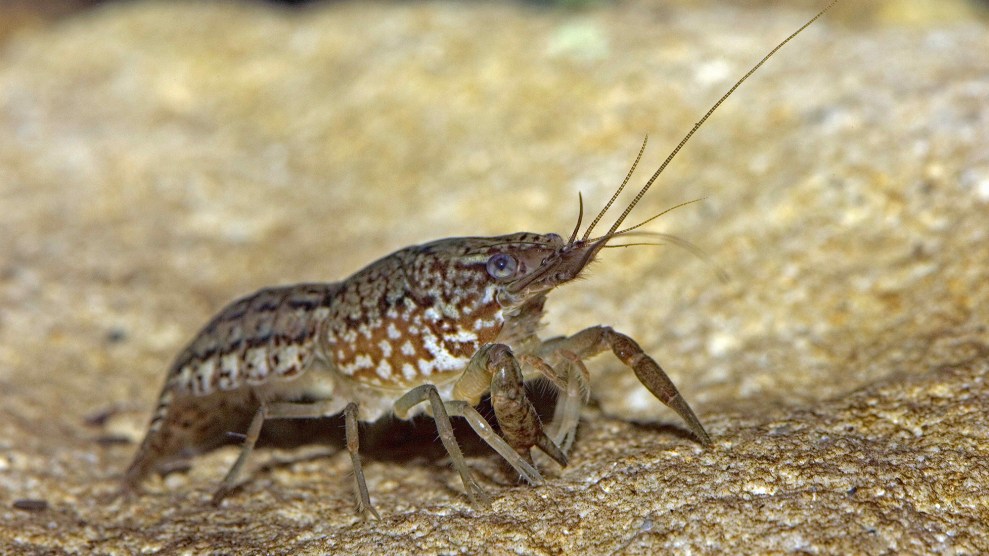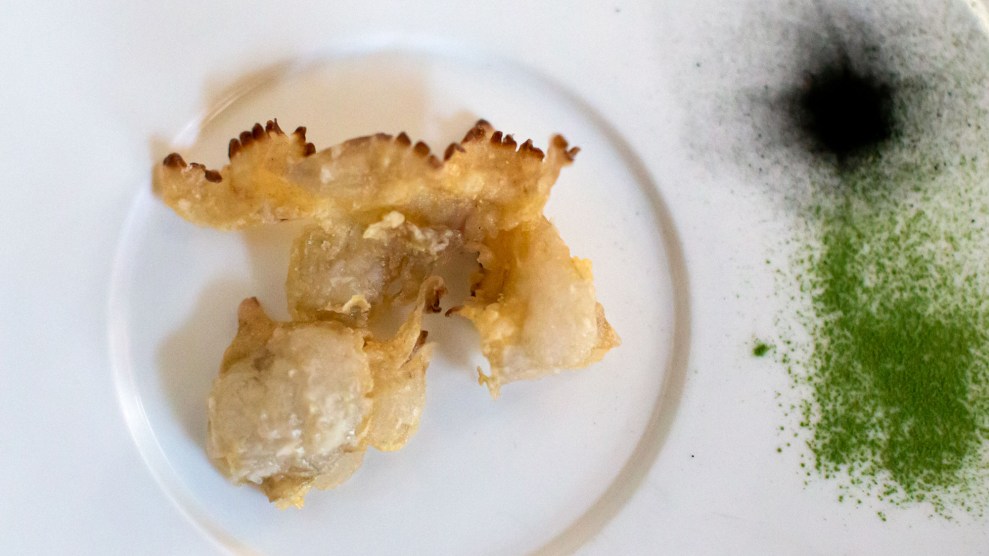
Jellyfish could be a plentiful food source, but finding appetizing ways to prepare them is not easy.Agostino Petroni
This story was originally published by Hakai Magazine and is reproduced here as part of the Climate Desk collaboration.
On a snowy January morning in 2022, I walk into Duo, an exclusive little restaurant in the heart of the southern Italian town of Lecce, carrying a polystyrene box filled with two frozen plate-sized jellyfish. Antonella Leone, a senior researcher at the Italian National Research Council’s Institute of Sciences of Food Production, is with me holding an authorization letter for chef Fabiano Viva to legally handle the sea creatures. Viva awaits us at the restaurant’s entrance, greets us with a hearty handshake, and takes the cooler. Within minutes, his assistant is defrosting the jellyfish under the tap. Viva laces up his white apron, fills a pot with water, and ignites the stove.
Leone is part of a small group of scientists who have been studying Mediterranean jellyfish for the past 12 years. For the last seven, they have involved chefs, testing ways to get the general public interested in eating the marine invertebrate.
“The idea of eating a jellyfish never crossed our minds, because we would only see one every once in a while,” Leone explains. But as several species of local and alien jellyfish became increasingly abundant—such as in 2014 when a jellyfish bloom saw 400 tonnes of the barrel jellyfish per square kilometer carpeting the massive Gulf of Taranto—Leone wondered what they could do with them.
But convincing Italians to eat jellyfish is like enticing them to try pineapple on pizza––not a simple task. Southern Italians eat octopus, sea urchin, and other sea creatures, but jellyfish are largely ignored. Selling jellyfish for human consumption is prohibited in the European Union, as regulators still do not consider the sea creature a safe, marketable food due to historical lack of interest in them as a food source, which is why Leone arrived at Duo with a permission letter in hand.
Safety concerns around jellyfish don’t seem to be a problem in China, where jellyfish have been on the menu for almost two millennia. (A favorite is an appetizer of chilled jellyfish seasoned with dark vinegar, sugar, soy sauce, chicken stock powder, and sesame oil.) Today, 19 countries harvest up to one million tonnes of the gelatinous sea dweller, contributing to a global industry worth around $160 million.
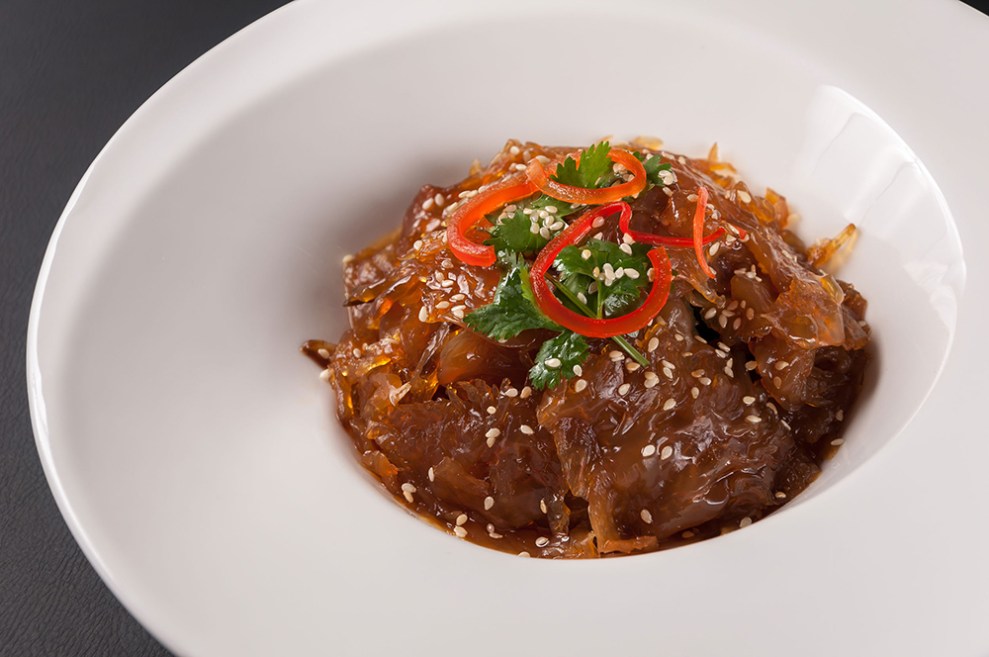
Jellyfish pickled in vinegar is one of the more popular ways to serve the gelatinous invertebrate.
momo2050/Shutterstock via Hakai
Paired with forward-looking chefs like Viva, Leone and her team began researching ways to make jellyfish tasty and safe for Mediterranean menus in 2015. As ocean fish stocks continue to deplete at alarming rates, and jellyfish seem to be thriving, more and more people are asking if eating jellyfish will effectively mitigate the jellyfish problem, and if they will become a sustainable and safe source of food. But can jellyfish become a food of the future, not just for adventurous diners eating at upscale restaurants, but for all?
Jellyfish are in a broad group of aquatic animals that marine biologists refer to as “gelatinous macrozooplankton.” There are some 4,000 known species worldwide, probably others unknown. They can be as small as a cereal flake, like the highly venomous Irukandji box jellyfish mainly found off the coast of Australia, or have tentacles up to 36 meters long, like the enormous lion’s mane jellyfish. Jellyfish are an important part of marine ecosystems and serve as meals to 124 fish species and 34 other animals, such as the leatherback sea turtle.
But all is not well in the jellyfish world. Since the turn of this century, scientists have witnessed a worrying increase in jellyfish populations in various parts of the world. According to Lucas Brotz, a researcher who has long studied jellyfish at the Institute for the Oceans and Fisheries at the University of British Columbia, it’s not easy to understand the reasons behind the phenomenon.
“Not all jellyfish are increasing in all places, but we do see a sort of sustained major increase in many areas around the world,” says Brotz. And there are myriad reasons that could be driving this change, among them alien jellyfish species being introduced into new areas and range expansion as climate change and warming waters favor some species over others.
The jellyfish increase is being felt particularly hard in places like the Mediterranean Sea and along the coast of Japan. Hordes of jellyfish have destroyed fish farms, clogged power plants, capsized fishing boats as they weighed down nets, and upended tourism by making waters unsafe for swimming. And their presence can impact creatures they share the sea with, too.
“Imagine [something the size of] the biggest oil tanker in the world, traveling along the Mediterranean coasts to Israel, consuming all the plankton,” says Stefano Piraino, Leone’s husband and a marine biologist and jellyfish expert at the University of Salento in Lecce, as he explains how massive blooms of jellyfish can hog all the plankton that other planktivores need.
Seeing the new availability of jellyfish in the Mediterranean, Piraino joined Leone in her quest to find possible culinary uses of jellyfish.
Back at Duo, Viva slips on latex gloves and carefully lifts the Rhizostoma pulmo jellyfish from below the running tap. They’re still a bit frozen, quite unlike the dried jellyfish used in Eastern cuisine, which must be rehydrated before use. Viva slips the jellies into a pot of boiling water and starts to stir.
When Leone started studying how jellyfish could be used for food or food ingredients—and how they could be preserved for later use—she stumbled upon one main problem. The primary method to preserve jellyfish, as perfected in Asia, was to dehydrate them using the chemical compound alum. But alum is considered toxic for human consumption and its use doesn’t meet the European Food Safety Authority’s standards. So Leone and her colleagues set out to devise a new and nontoxic way to desiccate edible jellyfish.
Her team overcame the drying challenge by using calcium salts instead of alum and went on to experiment with dried, fresh, and frozen jellies, turning them into mousse, meringue, seasonings, and thickeners.
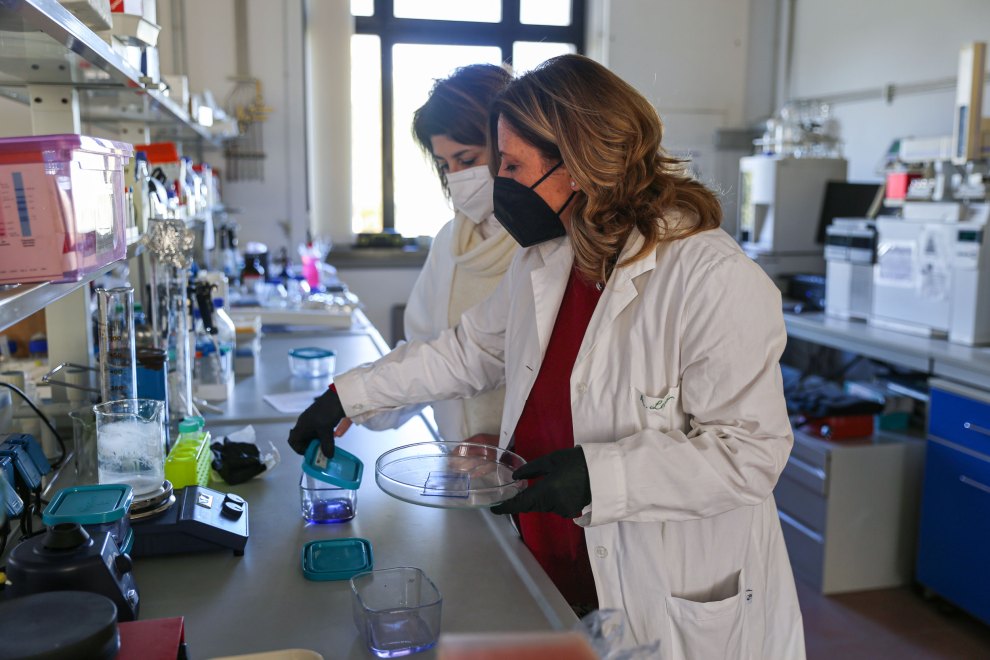
Antonella Leone, front, a senior researcher at the Italian National Research Council’s Institute of Sciences of Food Production, works with chefs to make jellyfish palatable to the public.
Agostino Petroni
The magic of turning gelatinous macrozooplankton into food and food products happens in Leone’s lab at the Institute of Sciences of Food Production, where she and her team of seven run their experiments. A long steel testing table with two shelves of transparent jars and scales at its center separates the expansive room. Inside an industrial fridge rest racks of test tubes containing jellyfish extracts to study.
But it is one thing to do research in a lab, and another to convince Italians to consider replacing fish with jellyfish in a soup. According to a 2020 study led by Luisa Torri, a professor of food science and technology at the University of Gastronomic Sciences of Pollenzo, there might be some hope for acceptance. The study surveyed 1,445 people on their attitude toward the idea of consuming jellyfish, taking into consideration traits such as age, behavioral habits, and mouthfeel, and showed that young, well-traveled people with higher education levels and sensitivity to the environment are the ones more likely to eat jellyfish.
I fit that category, so when Viva invites me to take a whiff of the white foam now bubbling rapidly on the stove, I try to keep an open mind.
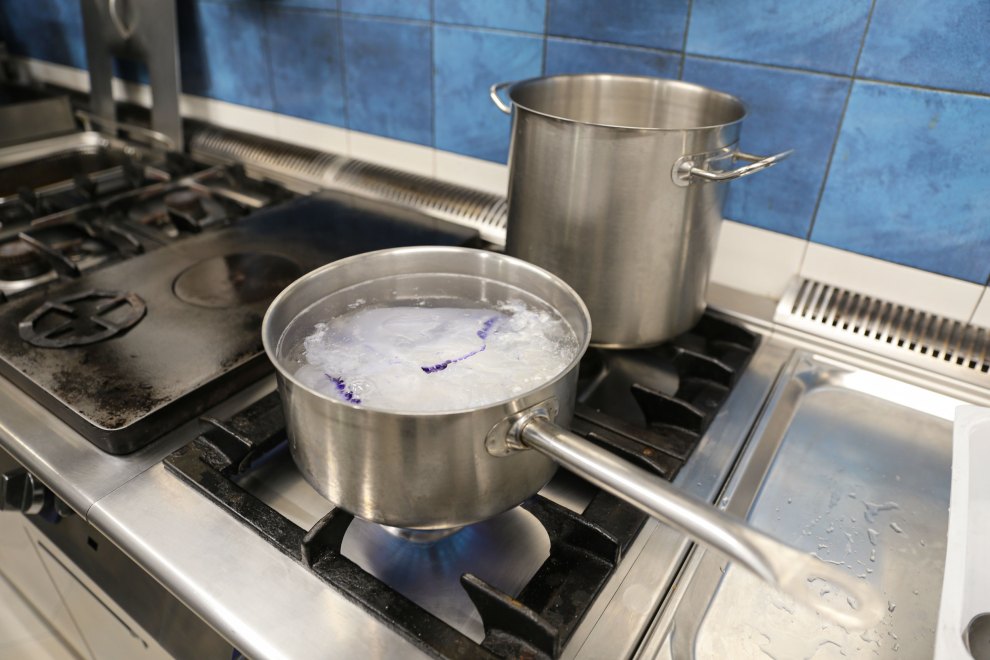
At the restaurant Duo, in Lecce, Italy, a jellyfish-forward meal begins by boiling the frozen invertebrates.
Agostino Petroni
I close my eyes and breathe deeply. “It smells like oysters,” I tell him.
“You need to disconnect your brain from what you know,” says Viva. “You need to detach yourself from the food in your memory.”
Is the key to accepting an unusual food making new food memories? If that’s the case, we’ll need to find a way to get jellyfish from the sea to dinner tables.
As well as helping to deal with future seas full of jellyfish, fishing for these creatures has been touted as a way to help small-scale European fishers, who are struggling with low fish stocks.
“A source of income? That would be great!” says Rocco Cazzato, a sixth-generation small-scale fisher from Tricase Porto, at the idea of fishing jellyfish. “But I would never eat them, not even if it’s the last thing left in the world to eat.”
Cazzato recounts the pain of pulling on his fishing nets crowded with jellyfish that he could not sell, and he says that if jellyfish were in demand locally like the commonly consumed scorpionfish, those jellyfish in the net would help small fishers like him make ends meet.
Although Leone is working to fill the information void, knowing which jellyfish are edible and safe for consumption is still a question few researchers are tasked with answering. According to Brotz, while many different jellyfish types are increasing worldwide, only a handful of them are preferred for human consumption. And just because they seem to be more abundant, it doesn’t mean that fishing them will be a panacea. The title of a 2016 paper Brotz coauthored says it all: “We should not assume that fishing jellyfish will solve our jellyfish problem.”
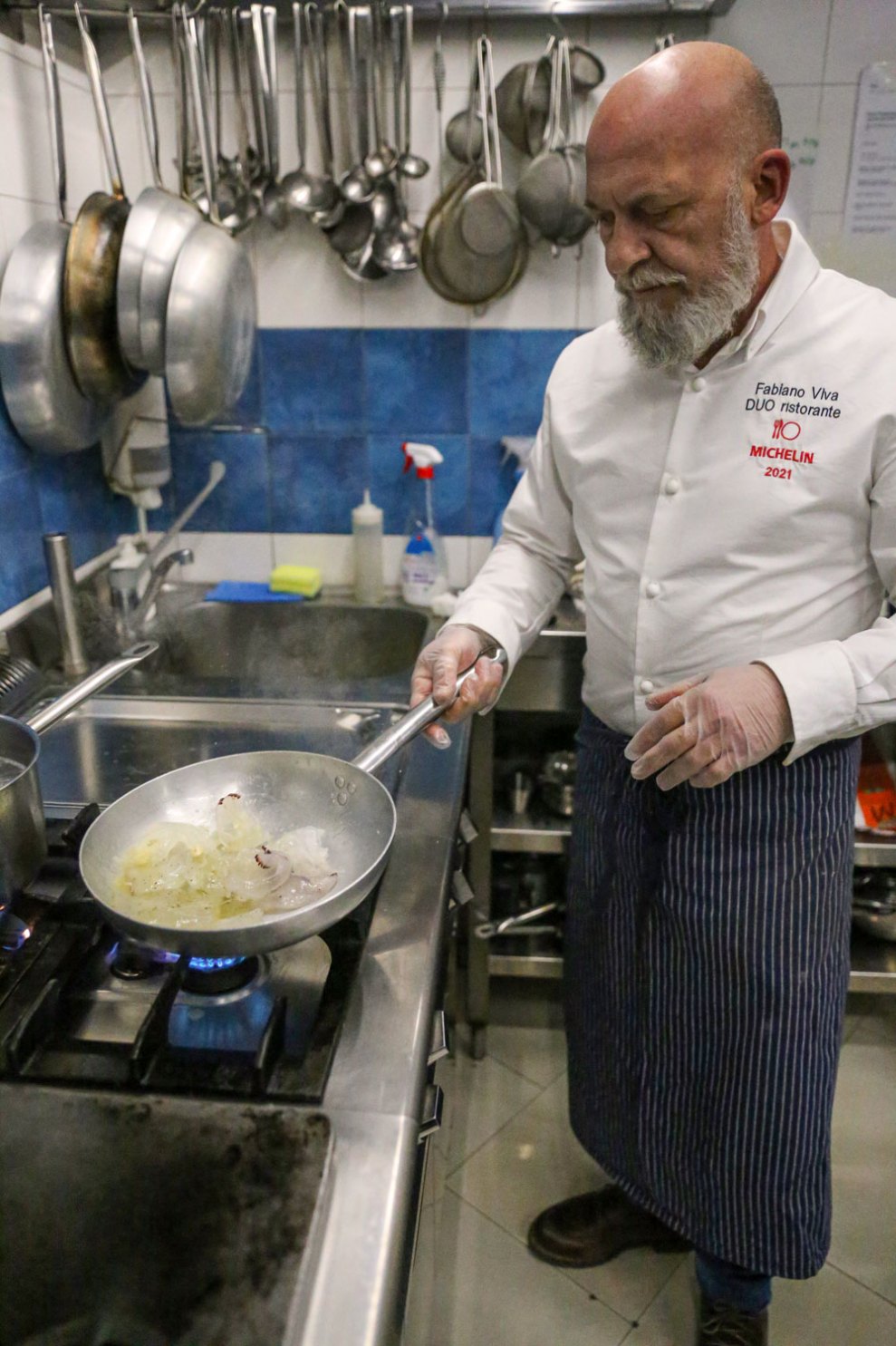
Chef Fabiano Viva, of Duo, sautés a jellyfish.
Agostino Petroni
The paper advises caution: jellyfish are understudied, and the effects of removing them from the ecosystem, even when they are in excess, are unknown and potentially negative. Some jellyfish, for instance, act as nurseries for juvenile fish, and jellyfish can be both predator and prey in food chains.
Silvestro Greco, research director at the Anton Dohrn Zoological Station, echoes the concern that fishing isn’t necessarily the way to combat jellyfish blooms. He fears that once industrial jellyfish extraction begins, quick depletion might have unexpected consequences on local marine environments. In the early 2000s, for instance, a portion of the fishing fleet in the Gulf of California, Mexico, diverted its efforts to harvesting jellyfish. Fishers and processing plant workers quickly profited from the new market, but overfished the resource, leading to the rapid depletion of jellyfish.
Still, some fishers are poised to launch if a fishery opens—there is already Asian interest in fishing jellyfish in the Mediterranean. But even with interest from fishers, if there’s no market, then there’s no point.
According to Leone, the enterprise of getting jellyfish to the masses needs an entrepreneur willing to invest the several thousand euros needed to request that the European Food Safety Authority (EFSA) accepts jellyfish as edible food for sale, allowing them to be legally sold in fish markets and restaurants.
Leone believes that, with her team, she’s gathered the scientific research to support such an application to EFSA and that some entrepreneurs have shown interest. It’s only a matter of time before some species of jellyfish make the list of approved European foods, she says, and she’s keen to broker the divide between fishers, markets, and chefs.
Creating this market could help artisanal fishers, the ones most affected by jellyfish blooms, Leone says. “They come back with nets full of jellyfish and three fish inside. If jellyfish would become accepted edible food, they could sell it as sea products like others.”
Leone first targeted curious chefs—ones without preconceptions, eager to accept a challenge—in 2015, and they became important team members. Leone and her team are part of the EU-funded GoJelly project that looked into innovative uses for jellyfish—including in fertilizers, cosmetics, and nutraceuticals, and for snaring microplastics. Membership means that Leone can regularly bring Viva and other chefs jellyfish to experiment with in their kitchens and find ways to make the sea creature appetizing. Over the years, Viva has tried the jellyfish pickled and dehydrated like chips, and as an ingredient in soups and pasta sauces.
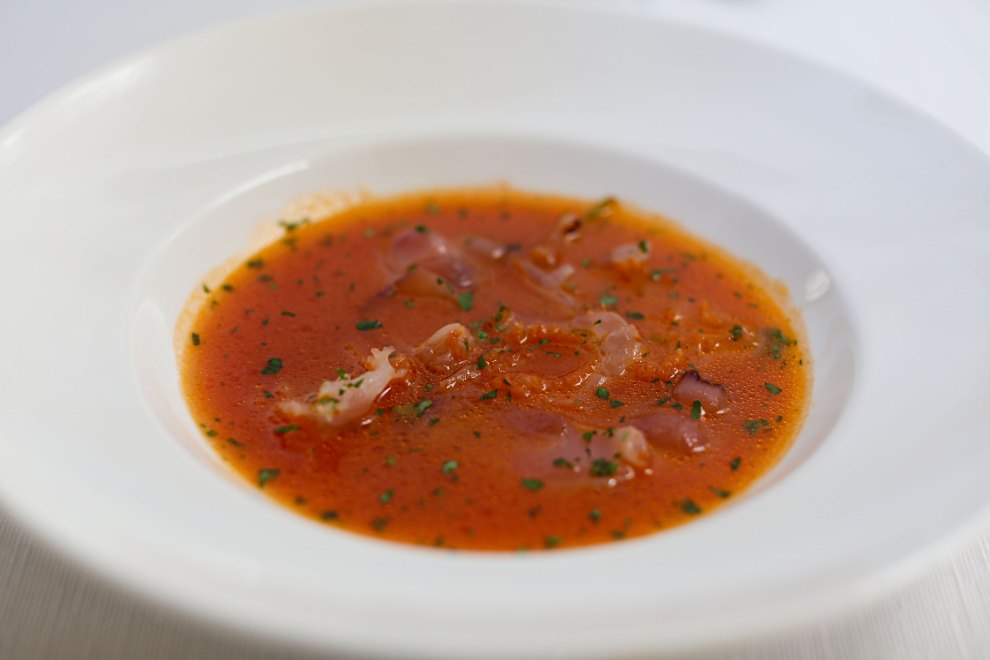
Chef Viva’s jellyfish soup in a broth of tomatoes, olive oil, garlic, and parsley.
Agostino Petroni
The most significant difficulty that Pasquale Palamaro, chef of the Michelin-star restaurant Indaco on the island of Ischia, encountered was the drop in weight as the jellyfish was cooked.
Jellyfish are 95 percent water and a small percentage of proteins, so when the animal dies, it loses much of the water. To avoid this loss, Palamaro believes they have to be consumed fresh within a few hours of harvest or stored safely frozen or preserved with the calcium salt technique that Leone developed.
Palamaro boils the Pelagia jellyfish from the Mediterranean for one minute, marinates it in citruses for an hour, and then seasons it with pumpkin seed oil before serving it with quinoa. Gennaro Esposito, chef of the Michelin-star restaurant Torre del Saracino in Vico Equense, prefers to pair the jellyfish with marinated cucumbers, chili kefir, and lettuce paste. Leone has collected the more successful recipes of these chefs and others in the freely available European Jellyfish Cookbook.
But not all chefs are convinced of the jellyfish’s culinary potential. In 2017, Greco, a marine biologist but also a food scientist and an avid cook, fried 50 kilograms of Pelagia jellyfish at the Slow Fish conference in Genova, Italy, to create awareness about the rapid rise in jellyfish numbers in the Mediterranean.
“It was a success,” Greco says, “but because they were fried. Everything fried is good.”
He believes jellyfish don’t have an interesting texture and don’t make a compelling case for culinary indulgence. All in all, he doesn’t believe that jellyfish will be quickly adopted by cuisines that traditionally never used them.
But according to Leone, jellyfish today are in the same situation as tomatoes in the 16th century. Tomatoes, now a key ingredient in traditional Mediterranean cuisine, were unknown before being brought over from the Americas around the 1550s. At first, they were thought to be toxic and unhealthy. Still, possibly thanks to forward-looking cooks, or simply because of necessity, tomatoes began appearing on pizzas and in parmigiana and pasta sauce, ultimately becoming part of the Mediterranean diet.
Whether or not jellyfish take a similar trajectory and become accepted in Western markets is hard to say, but many of our favored seafoods are declining or have already collapsed explains Brotz. “We may get to a point where there is no other seafood available.”
Back in the kitchen at Duo, Viva has turned one of the two jellyfish into a soup, adding tomato sauce, olive oil, a garlic clove, and a pinch of parsley. He offers me a serving.
I spot the turgid tentacles and part of the cap floating in the orange liquid, and my stomach turns. The first spoonful of broth goes down quickly. It tastes like a delicious––and fishy––tomato soup. Then I search for a piece of the jellyfish. I hesitate. I slurp it up.
It feels like a gulp of the sea itself as the flavor of the jellyfish unfurls in my mouth with the strength of a tsunami. The texture reminds me of calamari or a piece of fat from a cooked steak. As I chew, trying to repress the impulsive disgust, I think of cooked tripe. I swallow.

